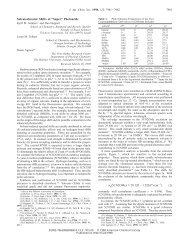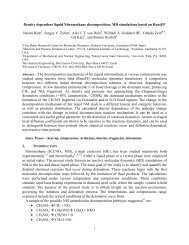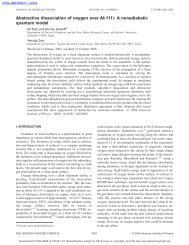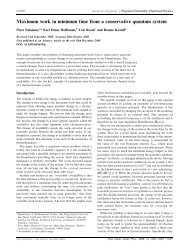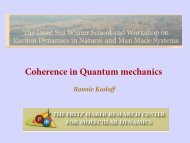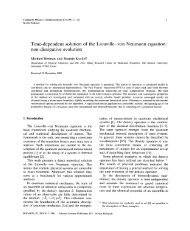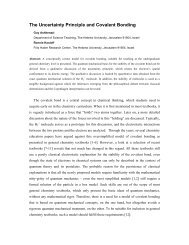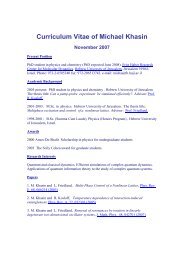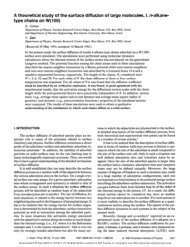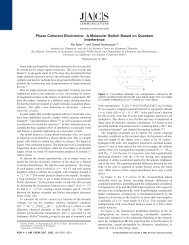Molecular Symmetry Properties of Conical Intersections and ...
Molecular Symmetry Properties of Conical Intersections and ...
Molecular Symmetry Properties of Conical Intersections and ...
Create successful ePaper yourself
Turn your PDF publications into a flip-book with our unique Google optimized e-Paper software.
3002 J. Phys. Chem. A, Vol. 114, No. 9, 2010 Al-Jabour et al.<br />
Figure 5. Adiabatic potentials V0 (black continuous lines), V1 (gray continuous lines), <strong>and</strong> V2 (dashed lines) <strong>of</strong> C5H4NH as a function <strong>of</strong> the<br />
torsional angle for r ) 1.0 Å (a), 0.8 Å (b), <strong>and</strong> 1.2 Å (c).<br />
LH loops LH2 <strong>and</strong> LH3 but not in LH1. The CIs can be located<br />
by interpolation on paths which connect anchors <strong>of</strong> the<br />
surrounding LH loop with different local IREPs, e.g., between<br />
opposite transition states. 39 Specifically, for LH2, a CI between<br />
the PES V0(s) <strong>and</strong> V1(s), denoted as S0/S1 CI (1A′/1A′′), is located<br />
on the connecting line between TSinversion 1A′ <strong>and</strong> TSbiradical 1A′′,<br />
close to TSbiradical 1A′′. The line is illustrated schematically in<br />
Figure 3, together with the geometry <strong>and</strong> energy <strong>of</strong> the CI.<br />
Likewise, LH3 should support another CI between V0 <strong>and</strong> V1 located<br />
on the line between TSbiradical 1A′ <strong>and</strong> TSbiradical 1A′′. A systematic<br />
search along this line yields even a triple degeneracy <strong>of</strong> V0, V1,<br />
<strong>and</strong> in addition V2. This triple CI is denoted S0/S1/S2 CI (1A′/<br />
1A′′/2A′), as shown in Figure 3. A triple CI is a connecting<br />
point <strong>of</strong> the seams <strong>of</strong> the S0/S1 <strong>and</strong> S1/S2 CIs. These seams will<br />
be investigated below, cf. item x. The existence <strong>of</strong> this triple<br />
degeneracy is implied by the coexistence <strong>of</strong> three different<br />
reaction coordinates from the syn-A′ form <strong>of</strong> C5H4NH via three<br />
different TSbiradical 1A′, TSinversion 1A′, <strong>and</strong> TSbiradical 1A′′ to the<br />
anti-A′ form. 34 The energy <strong>of</strong> S0/S1/S2 CI (1A′/1A′′/2A′) relative<br />
to the potential minimum, ∆E ) 3.46 eV, is larger than ∆E )<br />
2.80 eV for S0/S1 CI (1A′/1A′′), because, in general, V2 g V1 g<br />
V0.Forcomparison,theverticalexcitationenergyforFranck-Condon<br />
transition from the syn-A′ or anti-A′ forms <strong>of</strong> C5H4NH (S0) to<br />
the S1 state is 4.47 eV, which is enough to reach all <strong>of</strong> these<br />
funnels <strong>and</strong> transition states.<br />
Step 2: After location <strong>of</strong> two representatives <strong>of</strong> the CIs, we<br />
define convenient molecular-symmetry C2V(M)-adapted coordinates<br />
s ) {sk}. The different geometries <strong>of</strong> the syn <strong>and</strong> anti<br />
forms <strong>of</strong> C5H4NH, the three TSs, <strong>and</strong> the CIs (Figure 3) show<br />
that one would need, in principle, many such coordinates sk to<br />
describe motions between these configurations in detail. In view<br />
<strong>of</strong> our goal to demonstrate MS effects on NACTs <strong>and</strong> CIs as a<br />
pro<strong>of</strong> <strong>of</strong> principle, the criteria for our choice <strong>of</strong> the sk are less<br />
ambitious: We shall choose only two coordinates s ) {s1,s2}<br />
while freezing all the others; this is <strong>of</strong> course at the expense<br />
<strong>of</strong> covering the whole configuration space for all <strong>of</strong> the<br />
stationary points <strong>and</strong> all CIs <strong>of</strong> V0. Instead, we focus on a<br />
scenario for large amplitude motions which start in the<br />
domain close to the syn form <strong>of</strong> C5H4NH, say after<br />
Franck-Condon (FC) excitation from S0 to S1, via the CI with<br />
smallest energy, i.e., S0/S1 CI (1A′/1A′′), to the anti form in the<br />
electronic ground state S0. Since S0/S1 CI (1A′/1A′′) is close to<br />
TSbiradical A′′ for torsional motion from the syn form to the anti<br />
form <strong>of</strong> C5H4NH, cf. Figure 3, one <strong>of</strong> our molecular-symmetryadapted<br />
coordinates should describe torsional motion.<br />
Before giving a precise definition for the torsion angle <strong>and</strong><br />
also for the second MS-symmetry-adapted coordinate, let us<br />
first consider how to “freeze” the complementary coordinates.<br />
For this purpose, we note that all <strong>of</strong> the structures shown in<br />
Figure 3 have similar C5H4N fragments; it will, therefore, be<br />
reasonable to freeze the coordinates <strong>of</strong> the C5H4N fragment in<br />
a C2V(M) symmetry-adapted manner. There are various ways<br />
to do that. Our choice is based on the observation that, for the<br />
syn form <strong>of</strong> C5H4NH, the C5H4N fragment is planar (local Cs<br />
symmetry), but it does not have another perpendicular symmetry<br />
plane. In contrast, for S0/S1 CI (1A′/1A′′), the five-membered<br />
carbon ring turns out to be not exactly but almost planar. More<br />
specifically, here the shape <strong>of</strong> the C5H4NH fragment looks like<br />
the symmetrical (Cs) wings <strong>of</strong> a butterfly folded away from the<br />
planar reference plane, by just 0.0367 radians (2.1°), with the<br />
CN bond as the “head <strong>of</strong> the butterfly”, in the (local) vertical<br />
symmetry plane between the “wings”. The two limiting albeit<br />
very similar geometries <strong>of</strong> the C5H4N fragment for the syn <strong>and</strong><br />
anti forms as well as for S0/S1 CI (1A′/1A′) suggest, as a<br />
compromise, that this fragment should be frozen such that it<br />
has both perpendicular symmetry planes; i.e., it should have<br />
local C2V symmetry, with the nuclear coordinates close to those<br />
<strong>of</strong> the limiting forms. For simplicity, we freeze all bond lengths<br />
<strong>and</strong> bond angles <strong>of</strong> the “butterfly” form <strong>of</strong> S0/S1 CI (1A′/1A′),<br />
except that the “wings” are rotated just slightly by those 0.0367<br />
radians such that the C5H4 ring becomes planar; at the same<br />
time, the “head”, i.e., the CN bond, is also rotated by just 0.004<br />
radians into the plane <strong>of</strong> the C5H4 fragment. As a consequence,<br />
the local symmetry <strong>of</strong> the C5H4N fragment becomes C2V, with<br />
the CN axis as the (local) C2 axis. The distance <strong>of</strong> the proton<br />
<strong>of</strong> the NH bond from this CN axis is r ) 1.0 Å. Figure 3 shows<br />
that all geometries <strong>of</strong> the C5H4N fragment are similar to this<br />
C2V structure, not only for S0/S1 CI (1A′/1A′′) but also for all <strong>of</strong><br />
the other stationary points <strong>of</strong> V0. Furthermore, Figure 1b shows<br />
that this C2V geometry is robust with respect to all symmetry<br />
operations E, (12), E*, <strong>and</strong> (12)* <strong>of</strong> C2V(M); i.e., this geometry<br />
<strong>of</strong> the C5H4N fragment is described implicitly in terms <strong>of</strong> frozen,<br />
symmetry-adapted coordinates, which need not be specified,<br />
however, because they are irrelevant for the purpose <strong>of</strong> this<br />
paper. With this implicit definition <strong>of</strong> the frozen coordinates,<br />
the symmetry-adapted torsional angle <strong>and</strong> the complementary<br />
“radial” coordinates are defined as two cylindrical coordinates<br />
for rotation <strong>of</strong> the proton <strong>of</strong> the NH bond around the CN axis,<br />
relative to the C5H4N (C2V) fragment. Their (global) IREPs are<br />
A2 <strong>and</strong> A1, respectively, cf. Table 1. The “prize” for this<br />
reasonable <strong>and</strong> rather simple choice <strong>of</strong> just two C2V(M)-adapted<br />
coordinates is that motions along s ) {r, } may approach<br />
geometries <strong>of</strong> the syn <strong>and</strong> anti forms <strong>of</strong> C5H4NH as well as<br />
S0/S1 CI (1A′/1A′′) rather closely but not perfectly. For example,<br />
the syn <strong>and</strong> anti forms <strong>and</strong> the S0/S1 CI (1A′/1A′′) are<br />
approximated for {r, } ) {1.0 Å, 0}, {1.0 Å, (π}, <strong>and</strong> {1.0<br />
Å, π/2}, respectively, but the energies 0.47 <strong>and</strong> 2.69 eV differ<br />
from the exact references, 0.00 <strong>and</strong> 2.80 eV, respectively.<br />
Step 3: Using the C2V(M)-adapted coordinates {r, }, the<br />
results for the quantum chemistry calculations <strong>of</strong> the adiabatic



